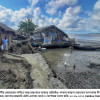Ensure safe water in Khulna coast

A longstanding problem in the country's coastal areas has been lack of access to safe drinking/usable water. This region is not only prone to the effects of climate change, but its water sources are also subject to salinity intrusion, with arsenic added to the mix in some areas. For example, as per a report by this daily, hundreds of people in Khulna's Kamarkhola union have to walk several kilometres every day to get clean water, as they cannot use water in their villages due to the intrusion of saline water and arsenic contamination. According to the Department of Public Health Engineering (DPHE), many of the 49 ponds in the Dacope upazila have dried up. Excavation work has been difficult to pursue because of disputes over the ponds. There are also not enough deep tube wells, while water in most of the upazila's 1,300 shallow tube wells is not drinkable because of the abovementioned reasons.
Unfortunately, this scenario seems to be prevalent across the coastal areas of Khulna.
Although salinity intrusion and arsenic contamination can occur naturally, there are human-made factors exacerbating this issue. For example, questions can be asked as to why the authorities are not exercising more control over shrimp cultivation in Khulna, Satkhira, and Bagerhat districts, given how its use of saltwater is affecting freshwater reservoirs. Also, while rainwater harvesting is recognised as one of the safest sources of water in the coast, it too has had little effect due to people's lack of awareness in this regard.
However, there are efforts underway which deserve recognition. For one, the UNDP's Gender-responsive Coastal Adaptation (GCA) project, with financial assistance from the Green Climate Fund (GCF) and the government, has helped 13,308 households in Khulna and Satkhira districts to harvest rainwater using a 2,000-litre tank. Moreover, this project has generated employment for 101 women (known as "Pani Apas") who have been trained to install and maintain the rainwater harvesting systems. Still, this is but a small step for a region in which at least 63 percent of the population faced difficulties in accessing drinking water in 2021, as per a UNDP survey.
We agree with the opinion of experts that the government should declare the southwestern coastal region a special zone and take proper measures to ensure its water safety. Ensuring access to safe water there will also help in achieving Goal 6 of the SDGs. The mere fact that around 68 million Bangladeshis lacked access to a reliable, safely managed source of water in 2022 shows how big a problem this is, as well as the urgency of appropriate steps to mitigate it. As such, projects addressing this problem should be undertaken and scaled up with funding from the government and our development partners. Access to safe drinking water is a human right. We must do everything to ensure that.


 For all latest news, follow The Daily Star's Google News channel.
For all latest news, follow The Daily Star's Google News channel. 








Comments